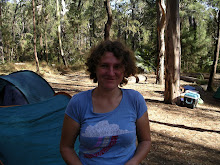 Courtesy of Flickr
Courtesy of FlickrA Voki is a talking avatar, a graphical representation of the creator. This may be an animal, cartoon person or even an adapted photograph. The Voki I choice has some resemblance to me (not a lot), but can certainly give you some clue of my personality. I have used it to welcome you to my blog and encourage comments. This gives a human element to my presentation and hopefully engages you to go further and read some of my entries.
Could talking avatars be used in the classroom to engage learners in real life problem solving projects? Could the introduction of a course with a speaking avatar engage the audio/visual/kinaesthetic learners? Or could it frustrate some learners if the voice isn't clear and is slightly comical?
The Voki I made was simple enough and could be accessible and fun to a range of ages. If you take it as face value as just an audio visual tool then according to Dale's (1960) Learning Pyramid, average retention of learning would be 20%. If used in an active, real life student centred, collaborative problem solving experience with a real audience and clear outcomes, the talking avatar becomes a tool to use immediately and to teach others - Dale's (1960) Learning Pyramid retention 90%.
Students may use this tool at the start of term to introduce themselves and their interests. This then could be added to a Wiki and incorporated with information (digital stories) about their home town and country. This may be linked to a foreign school to learn about their environment and how they live. Speaking avatars can be converted into different languages allowing easy communication and lots of language learning opportunities.
Children who have English as a Second Language (ESL) may find this tool invaluable for practice, communication and presentation of work. This can be done initially by typing in the sentence (encouraging literacy), then eventually recording their own voice. This is the same for those with Special Needs or even just the shy ones.
Of course it can be used for learning Languages Other Than English (LOTE) in a similar way. Not only do you have to get the grammar correct as you type in, but the pronunciation is given as a reward. Then you record your version and see if it sounds the same. You can even test it out on each other in a group setting to see if anyone understands what you are saying, ie. translate each other's speaking avatars and give feedback to improve. This encourages critical and deeper learning.
There are many authentic uses for speaking avatars, the last one I will comment about is for story telling. Given the task to create a character for your story using the Voki for example, and have them introduce it, is a great way to kick start a range of learners, particularly those with writers block! This can be incorporated into a Wiki and developed in a number of ways depending on what the students want to do!
I find this technology amazing coming from a computer free classroom of the 1980s! For a country where one in four people are born overseas and a huge number of different languages spoken at home other than English, this tool is fantastic. Not forgetting the attention of those gamers we call our children!
What do you think?
Cheers
Johanna

No comments:
Post a Comment